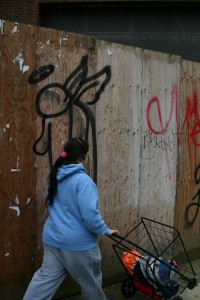
 The phrases “love your ghetto” and simply “love” might not seem like resistant or political language, but they do disrupt the stereotypes often placed on the community of the DTES.
The phrases “love your ghetto” and simply “love” might not seem like resistant or political language, but they do disrupt the stereotypes often placed on the community of the DTES.
Graffiti is a tool that has been used by minority groups to attack other minority groups with sexist, racist, or homophobic language, which often uphold privilege and inequality in society rather than resist them, a way to “enact or react to hegemonic conditions” (Rodriguez 1999:1). However, these images of graffiti reflect a different message being written in the DTES, home to many of the social tensions addressed above. Rather than tearing down other minority groups or directly criticizing authoritarian control, a message of loving your community is scrawled on the wood and in the pavement, and is done so anonymously and freely, without factors such social class, education, access, or position which so often dictate which members of society get to speak and be heard (Rodriguez 1999:2).
These words challenge hegemonic order, which often frames the neighbourhood as a place of crime, chaos, and society’s waste. The messages seen here begin to write out a new discourse among residents living in poverty that disturbs the dominating perceptions centred around the Eastside of addiction, violence, and disease. It’s a new message written by the community and for the community inviting radical peace in the face of societal barriers, inequality, and unjust systems, as is seen by the word “love” written amongst the barbed wire.
By: Sharlene Petigara
Rodriguez, Amardo, and Clair, Robin Patric.
1999 Graffiti as Communication: Exploring the Discursive Tensions of Anonymous Texts.The Southern Communication Journal 65 (1): 1.
